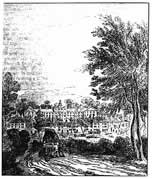INDUSTRIAL REVOLUTION: A DOCUMENTARY HISTORY
Series One: The Boulton & Watt Archive and the Matthew Boulton Papers from Birmingham Central Library
Part 11: Engineering Drawings, c.1801-1865
Part 11 completes our coverage of all the engineering drawings not already covered by Parts 3 and 5 of this microfilm project. They relate to the period after 1800 when James Watt Junior and Matthew Robinson Boulton increasingly took over the day to day running of the Boulton & Watt business interests. Included are engine drawings and portfolios covering new ventures such as steamboats and mint engines.
This material features over 7,600 drawings:
- Boat engines (a total of 286 engines relating to 151 different vessels including
Robert Fulton's Clermont, Watt's Caledonia, HMS Congo,
Princess Charlotte for
Clyde Steam Boat Company and a number of
44 Gun Frigates for the Royal Navy.
There are also drawings for vessels for the Hudson Bay Company,
the Sicilian Government, Ceylon, J B Humphreys for use on rivers in Germany, the Imperial & Royal Danube Steam Navigation Company,
Austrian Lloyd's Steam Navigation Company, Bombay Steam Navigation Company, Tyne Steam Packet Company,
John Molson in Montreal,
Dublin & London Steam Marine Company, Vander Hoop in Amsterdam,
the London & Margate Steam Packet Company, the Carlisle & Liverpool Steam Packet Company, and a series of vessels for the British Post Office).
- Mint engines (for the Royal Mint in London, based upon the Soho model, and for various important foreign Mints in Calcutta, Bombay, Lisbon, Copenhagen, Mexico, Brazil and as well as the third version of the Soho Mint which began operation in 1831).
- Pumping engines (including drawings for the Thetford drainage scheme, the Gravesend Tunnel, drainage schemes in Holland near the River Yssel, equipment for the Halbeath, Werneth, Harlet, Plasmostyn and Kenton collieries, the Carnarvon mine in North Wales, Wanlock Head lead mine and even one engine designed for the Nabob Vizier of Oude, in Lucknow, India).
- Crank engines (for cotton mills in Glasgow, Lancashire and Yorkshire, for a distillery in Fife, a ropery at Port Glasgow, a flax mill at Arbroath, a saw mill in Glasgow, a corn mill in Halifax, an oil mill in Hull, silk mills in Cheshire,
a colliery near Rotherham, Tyne Iron Company in Newcastle, Constitution Brewery in Spittalfields, a distillery in Whitechapel Road and a flint mill and pottery in Stoke. There are drawings dated November 1844 for the
Patent Welded Iron Tube Company in Wednesbury, Staffordshire. Other drawings are for the iron works at Bilston, Tredegar and Dowlais, for the glass works at Smethwick, Britannia Nail Company in Birmingham, the Deptford Corn Mill (ordered by George and John Rennie) and for the forge engine for the smithery at HMS Dockyard Woolwich. Further afield customers include a demerara sugar mill in the West Indies, a saw mill in New Orleans (May 1806), a corn or rice mill for the harbour at Baltimore (June 1817) and a saw mill for Georgia in the United States (October 1818). The geographical range in the distribution of Boulton & Watt engines is further shown by drawings for an engine for the armoury in Constantinople, a rope works in
St Petersburg and a flour mill in Cadiz).
- Dock and harbour engines (concentrating on the London Dock,
St Katherine's Docks, the West India Dock Company, the East India Dock Company (both in Bombay and London), Chatham and Woolwich Dockyards, the Dublin Custom House Dock, Liverpool, Leith and Holyhead Docks. Much of the material reveals the involvement of John Rennie with these projects).
- Vacuum and blowing engines (for the Carron, Tredegar, Old Park, Blaenavon, Dowlais, Plymouth and Calder Iron Works. Other portfolios cover drawings of the 1840s made for the South Devon Railway and for the London, Croydon & Epsom Railway).
- Canal Engines (for the Birmingham, Grand Junction, Kennet & Avon, Bridgwater & Taunton, Caledonian, Regents and Portsmouth & Arundel Canal Companies. There are also portfolios of drawings on the Katwyk and Rhine Canal).
- Engines for Water Works and Gas Plants (These were a definite feature of this period. There are many folders of drawings for New River, Chelsea, West Middlesex, East London, Clifton, Aberdeen and Glasgow Water Works. There are portfolios for other sites throughout Britain along with three folders for Hamburg. Gas Plants in Manchester, Leeds, Shrewsbury and Aberdeen are well covered).
- Side-Lever Engines (These include drawings for a Lead Works near Rotherhithe, Britannia Flour Mills in Birmingham, the Agua Fria Gold Mining Company in California, Vatch Mills near Stroud and several engines for Messrs Charles Mackintosh & Company.
- Small Side-Lever Independent Type Engines (Various designs for owners such as Josiah Spode, Barrow Lees & Company, Blackburn Spinning Company, two breweries in Dublin, Witham Navigation, Sir John Hope and a winding engine for Heaton Colliery.
- Independent type engines supplied to Sugar Plantations (for Trinidad, Tobago, Essequibo, Demerera, Jamaica, Grenada, Berbice, St Lucia, St Croix, Brazil, North Carolina and New Orleans).
- Miscellaneous drawings (including a double reciprocating engine at Soho Manufactory, sliding valve engines, drawings of equalizing beams and rotative motions, a Dutch windmill, the heating apparatus for Leamington Baths, sketches of boilers, atmospheric and various other types of early engines, flywheels, tooth-wheels, gears, connecting rods, nozzles, cylinders, condensers, copying presses, plans of the buildings for Soho Foundry and Soho Manufactory).
|

|















